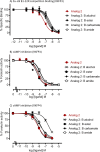Effects of C-Terminal B-Chain Modifications in a Relaxin 3 Agonist Analogue
- PMID: 33214850
- PMCID: PMC7667869
- DOI: 10.1021/acsmedchemlett.0c00456
Effects of C-Terminal B-Chain Modifications in a Relaxin 3 Agonist Analogue
Abstract
The receptor for the neuropeptide relaxin 3, relaxin family peptide 3 (RXFP3) receptor, is an attractive pharmacological target for the control of eating, addictive, and psychiatric behaviors. Several structure-activity relationship studies on both human relaxin 3 (containing 3 disulfide bonds) and its analogue A2 (two disulfide bonds) suggest that the C-terminal carboxylic acid of the tryptophan residue in the B-chain is important for RXFP3 activity. In this study, we have added amide, alcohol, carbamate, and ester functionalities to the C-terminus of A2 and compared their structures and functions. As expected, the C-terminal amide form of A2 showed lower binding affinity for RXFP3 while ester and alcohol substitutions also demonstrated lower affinity. However, while these analogues showed slightly lower binding affinity, there was no significant difference in activation of RXFP3 compared to A2 bearing a C-terminal carboxylic acid, suggesting the binding pocket is able to accommodate additional atoms.
© 2020 American Chemical Society.
Conflict of interest statement
The authors declare no competing financial interest.
Figures




Similar articles
-
Minimization of human relaxin-3 leading to high-affinity analogues with increased selectivity for relaxin-family peptide 3 receptor (RXFP3) over RXFP1.J Med Chem. 2012 Feb 23;55(4):1671-81. doi: 10.1021/jm201505p. Epub 2012 Feb 8. J Med Chem. 2012. PMID: 22257012
-
Differential effects of relaxin-3 and a selective relaxin-3 receptor agonist on food and water intake and hypothalamic neuronal activity in rats.Behav Brain Res. 2018 Jan 15;336:135-144. doi: 10.1016/j.bbr.2017.08.044. Epub 2017 Aug 31. Behav Brain Res. 2018. PMID: 28864207
-
C-terminus of the B-chain of relaxin-3 is important for receptor activity.PLoS One. 2013 Dec 11;8(12):e82567. doi: 10.1371/journal.pone.0082567. eCollection 2013. PLoS One. 2013. PMID: 24349312 Free PMC article.
-
[A new agent in the mechanisms underlying addiction and ingestion of alcohol: the nucleus incertus and the neuropeptide relaxin-3].Rev Neurol. 2018 Sep 1;67(5):175-186. Rev Neurol. 2018. PMID: 30047120 Review. Spanish.
-
Increased feeding and body weight gain in rats after acute and chronic activation of RXFP3 by relaxin-3 and receptor-selective peptides: functional and therapeutic implications.Behav Pharmacol. 2012 Sep;23(5-6):516-25. doi: 10.1097/FBP.0b013e3283576999. Behav Pharmacol. 2012. PMID: 22854307 Review.
Cited by
-
Indole-Containing Amidinohydrazones as Nonpeptide, Dual RXFP3/4 Agonists: Synthesis, Structure-Activity Relationship, and Molecular Modeling Studies.J Med Chem. 2021 Dec 23;64(24):17866-17886. doi: 10.1021/acs.jmedchem.1c01081. Epub 2021 Dec 2. J Med Chem. 2021. PMID: 34855388 Free PMC article.
-
Discovery and Characterization of the First Nonpeptide Antagonists for the Relaxin-3/RXFP3 System.J Med Chem. 2022 Jun 9;65(11):7959-7974. doi: 10.1021/acs.jmedchem.2c00508. Epub 2022 May 20. J Med Chem. 2022. PMID: 35594150 Free PMC article.
References
-
- Bathgate R. A. D.; Samuel C. S.; Burazin T. C. D.; Layfield S.; Claasz A. A.; Reytomas I. G. T.; Dawson N. F.; Zhao C.; Bond C.; Summers R. J.; Parry L. J.; Wade J. D.; Tregear G. W. Human Relaxin Gene 3 (H3) and the Equivalent Mouse Relaxin (M3) Gene: Novel members of the relaxin peptide family. J. Biol. Chem. 2002, 277 (2), 1148–1157. 10.1074/jbc.M107882200. - DOI - PubMed
LinkOut - more resources
Full Text Sources
Chemical Information
Research Materials

